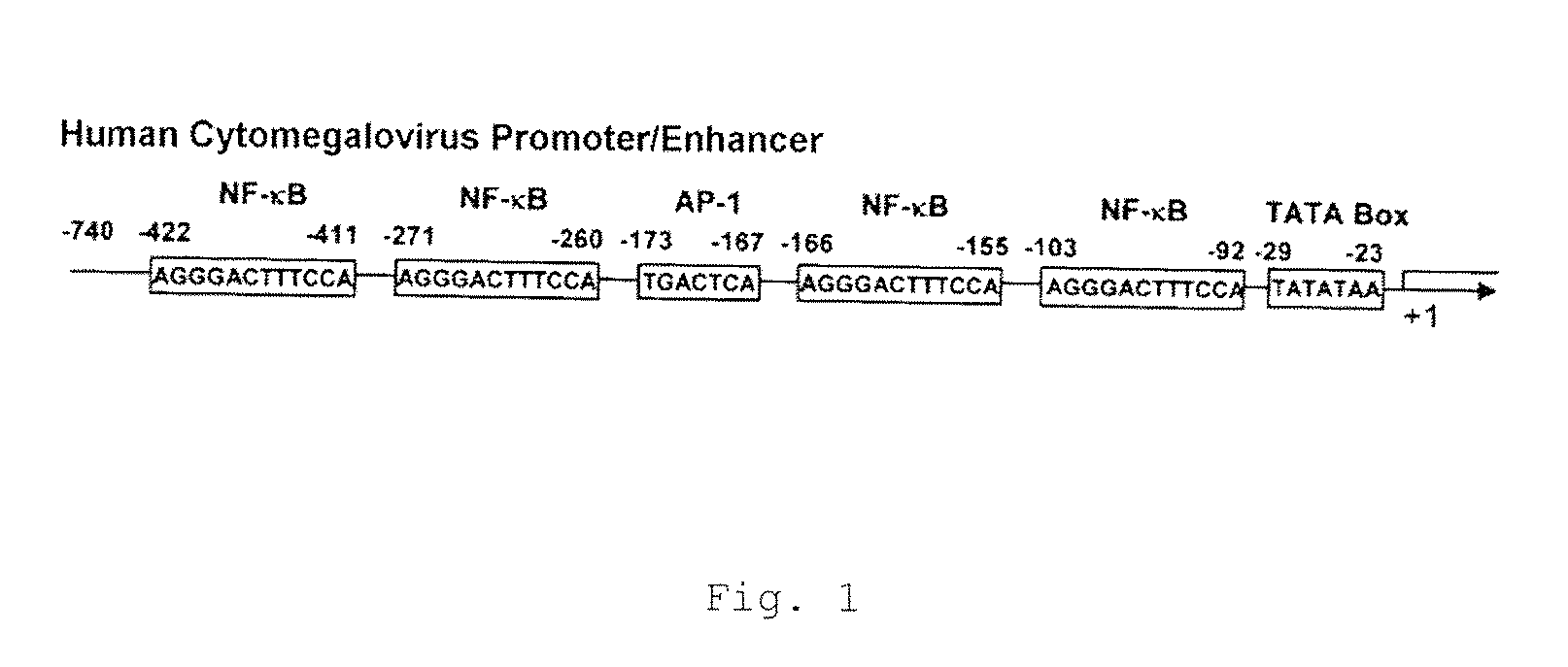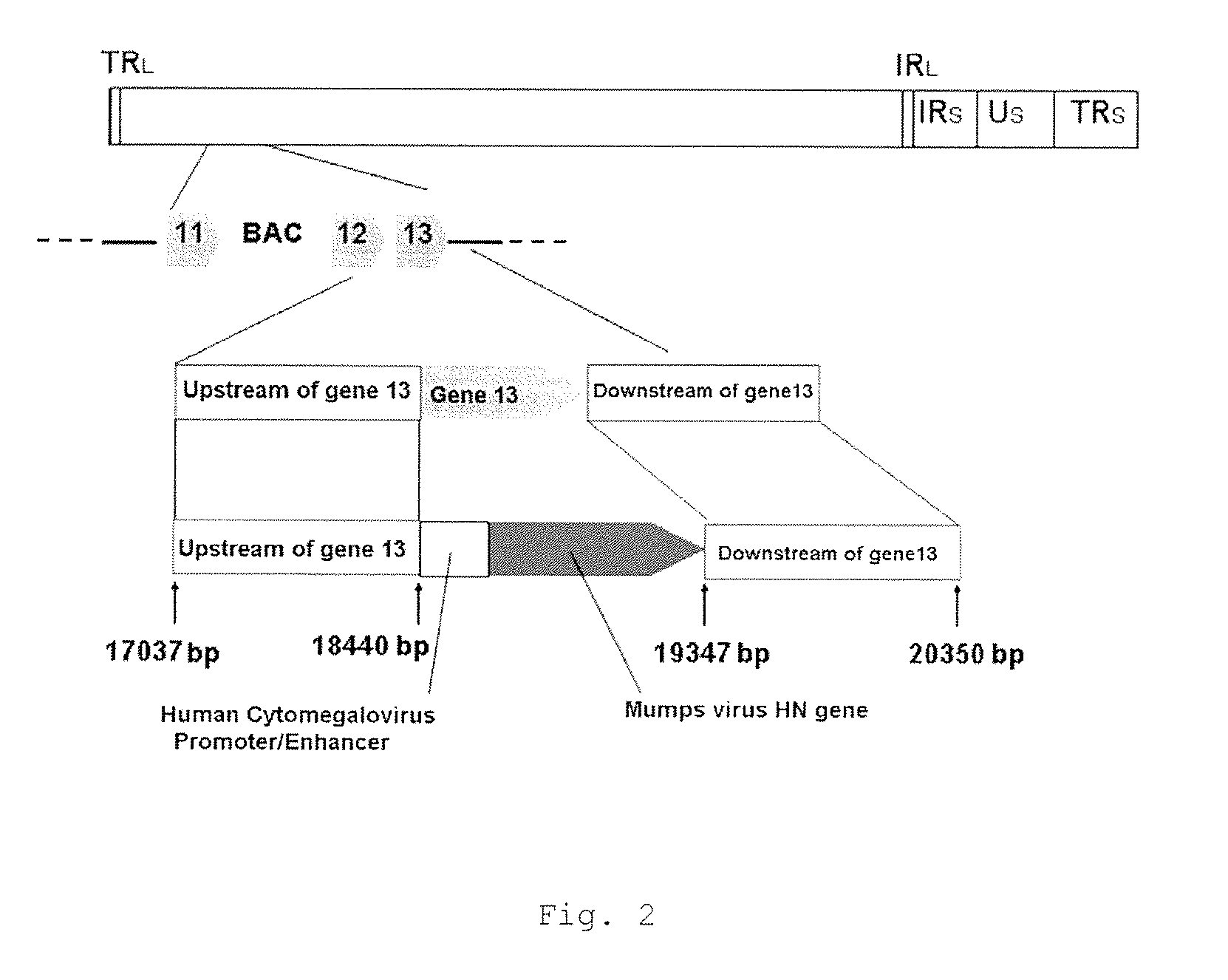Recombinant multivalent vaccine
a multi-valent, recombinant technology, applied in the direction of viruses, drug compositions, immunological disorders, etc., can solve the problems of insufficient quality control, insufficient quality assurance, and difficulty in developing vzv vaccines, so as to increase the accuracy of quality control and quality assurance, ensure the effectiveness, safety, and homogeneity of attenuated vaccines
- Summary
- Abstract
- Description
- Claims
- Application Information
AI Technical Summary
Benefits of technology
Problems solved by technology
Method used
Image
Examples
example 1
Selection of a Region (Gene) into which a BAC Vector is Inserted
[0167]When a recombinant virus in which a foreign antigen gene is inserted is produced utilizing a BAC vector, the size of the resulting genome becomes relatively large due to the insertion of a number of foreign genes. It is known that when the genome size is too large, the genome DNA cannot be packaged in a capsid, resulting in a failure to produce a recombinant virus. It is believed that to insert a number of antigen genes into the Oka vaccine strain, it is necessary to knockout a non-essential gene (of the Oka vaccine strain) to reduce the genome size. A non-essential gene in a virus which can proliferate even after the gene is knocked out is suitable as an insertion site for a foreign sequence such as a BAC vector sequence or a gene encoding an antigenic protein derived from another virus.
[0168]Thus, using recombinant DNA (P-Oka strain VZV-BAC-DNA) in which a varicella virus Oka original strain genome is inserted i...
example 2
Production of a Multivalent Vaccine by Inserting Mumps Virus HN Gene into ORF of Gene 13
[0173]Due to the fact that in Example 1 gene 13 was revealed a suitable gene for knockout and / or insertion of a foreign sequence, a multivalent vaccine was produced by inserting the mumps virus HN gene into the ORF of gene 13.
[0174]HN gene and F gene of the mumps virus were amplified from a field epidemic strain, Iwasaki strain, using PCR. When the amino acid sequences of F gene and HN gene of the Iwasaki strain cloned were analyzed, it was found that the F gene showed relatively high homogeny with field strains and vaccine strains (>98.5%), whereas the HN gene showed high homogeny with field strains from the late 1990s but showed low homogeny with field strains before the early 1990s and vaccine strains (about 96%).
[0175]Then, a promoter / enhancer sequence of human cytomegalo virus (CMV) was operatively linked upstream of the cloned gene. The plasmids using HN gene and F gene were designated as p...
example 3
Production of Mutant Recombinant Varicella-Zoster Virus with Low Pathogenicity
[0181]According to the present invention, it is possible to prepare a mutant recombinant varicella-zoster virus and to obtain a mutant varicella-zoster virus strain with low pathogenicity in a mutated virus using the following method.
(1: Preparation of Mutant Recombinant Varicella-Zoster Virus)
[0182]As a method for preparing mutant recombinant varicella-zoster virus including, for example, homologous recombination between a nucleic acid containing a mutated gene and VZV-BAC-DNA plasmid to produce mutant recombinant varicella-zoster virus. A mutated gene, which is used to cause homologous recombination with VZV-BAC-DNA plasmid may include random mutation and may include site-directed mutation. By employing each of the above methods, it is possible to obtain a population of mutant recombinant varicella-zoster virus with random mutation and a population of mutant recombinant varicella-zoster virus with site-d...
PUM
| Property | Measurement | Unit |
|---|---|---|
| pore size | aaaaa | aaaaa |
| size | aaaaa | aaaaa |
| size | aaaaa | aaaaa |
Abstract
Description
Claims
Application Information
 Login to View More
Login to View More - R&D
- Intellectual Property
- Life Sciences
- Materials
- Tech Scout
- Unparalleled Data Quality
- Higher Quality Content
- 60% Fewer Hallucinations
Browse by: Latest US Patents, China's latest patents, Technical Efficacy Thesaurus, Application Domain, Technology Topic, Popular Technical Reports.
© 2025 PatSnap. All rights reserved.Legal|Privacy policy|Modern Slavery Act Transparency Statement|Sitemap|About US| Contact US: help@patsnap.com



